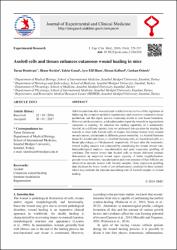| dc.contributor.author | Demircan, Turan | |
| dc.contributor.author | Keskin, İlknur | |
| dc.contributor.author | Günal, Yalçın | |
| dc.contributor.author | İlhan, Ayşe Elif | |
| dc.contributor.author | Kolbaşı, Bircan | |
| dc.contributor.author | Öztürk, Gürkan | |
| dc.date.accessioned | 08.07.201910:49:13 | |
| dc.date.accessioned | 2019-07-08T20:18:44Z | |
| dc.date.available | 08.07.201910:49:13 | |
| dc.date.available | 2019-07-08T20:18:44Z | |
| dc.date.issued | 2016 | en_US |
| dc.identifier.citation | Demircan, T., Keskin, İ., Günal, Y., İlhan, A. E., Kolbaşı, B. ve Öztürk, G. (2016). Axolotl cells and tissues enhances cutaneous wound healing in mice. Journal of Experimental and Clinical Medicine, 33(4), 229-237. https://dx.doi.org/10.5835/jecm.omu.33.04.010 | en_US |
| dc.identifier.issn | 1309-4483 | |
| dc.identifier.uri | https://hdl.handle.net/20.500.12511/454 | |
| dc.identifier.uri | https://dx.doi.org/10.5835/jecm.omu.33.04.010 | |
| dc.description.abstract | Adult mammalian skin wound repair is defective due to loss of the regulation in balancing the complete epithelial regeneration and excessive connective tissue
production, and this repair process commonly results in scar tissue formation. However, unlike mammals, adult salamanders repair the wounds by regeneration compared to scarring. To elucidate the healing capability of a salamander, Axolotl, in a different species, here we addressed this question by treating the wounds in mice with Axolotl cells or tissues. Excisional lesions were created
on each mouse, and animals in different groups treated by; a-) Axolotl blastema
tissue, b-) Axolotl tail tissue, c-) Axolotl blastema cells, d-) Axolotl tail cells, e-)
Serum physiologic, e-) Madecassol; respectively. 10 days after the treatments, wound healing success was compared by considering the wound closure rate,
histopathological analysis, vascularization and gene expression profiling of cytokines. The results reveal that Axolotl cells or tissues delivered animals demonstrate an improved wound repair capacity. A better reepithelization,
granule tissue formation, vascularization and even presence of hair follicles are
observed in animals treated with Axolotl samples. Gene expression profiling data discloses the lower levels of pro-inflammatory cytokines in these animals
which may indicate the immune-modulating role of Axolotl samples in wound healing. | en_US |
| dc.language.iso | eng | en_US |
| dc.rights | info:eu-repo/semantics/openAccess | en_US |
| dc.subject | Tıbbi Araştırmalar Deneysel | en_US |
| dc.subject | Axolotl | en_US |
| dc.subject | Cutaneous Wound Healing | en_US |
| dc.subject | Immune-Modulation | en_US |
| dc.subject | Regeneration | en_US |
| dc.title | Axolotl cells and tissues enhances cutaneous wound healing in mice | en_US |
| dc.type | article | en_US |
| dc.relation.ispartof | Journal of Experimental and Clinical Medicine | en_US |
| dc.department | İstanbul Medipol Üniversitesi, Tıp Fakültesi, Temel Tıp Bilimleri Bölümü, Tıbbi Biyoloji Ana Bilim Dalı | en_US |
| dc.department | İstanbul Medipol Üniversitesi, Tıp Fakültesi, Temel Tıp Bilimleri Bölümü, Histoloji ve Embriyoloji Ana Bilim Dalı | en_US |
| dc.department | İstanbul Medipol Üniversitesi, Tıp Fakültesi, Temel Tıp Bilimleri Bölümü, Fizyoloji Ana Bilim Dalı | en_US |
| dc.department | İstanbul Medipol Üniversitesi, Rektörlük, Rejeneratif ve Restoratif Tıp Araştırmaları Merkezi (REMER) | en_US |
| dc.authorid | 0000-0002-7059-1884 | en_US |
| dc.authorid | 0000-0001-7933-4262 | en_US |
| dc.authorid | 0000-0003-0352-1947 | en_US |
| dc.identifier.volume | 33 | en_US |
| dc.identifier.issue | 4 | en_US |
| dc.identifier.startpage | 229 | en_US |
| dc.identifier.endpage | 237 | en_US |
| dc.relation.publicationcategory | Makale - Uluslararası Hakemli Dergi - Kurum Öğretim Elemanı | en_US |
| dc.identifier.scopusquality | Q4 | en_US |


















